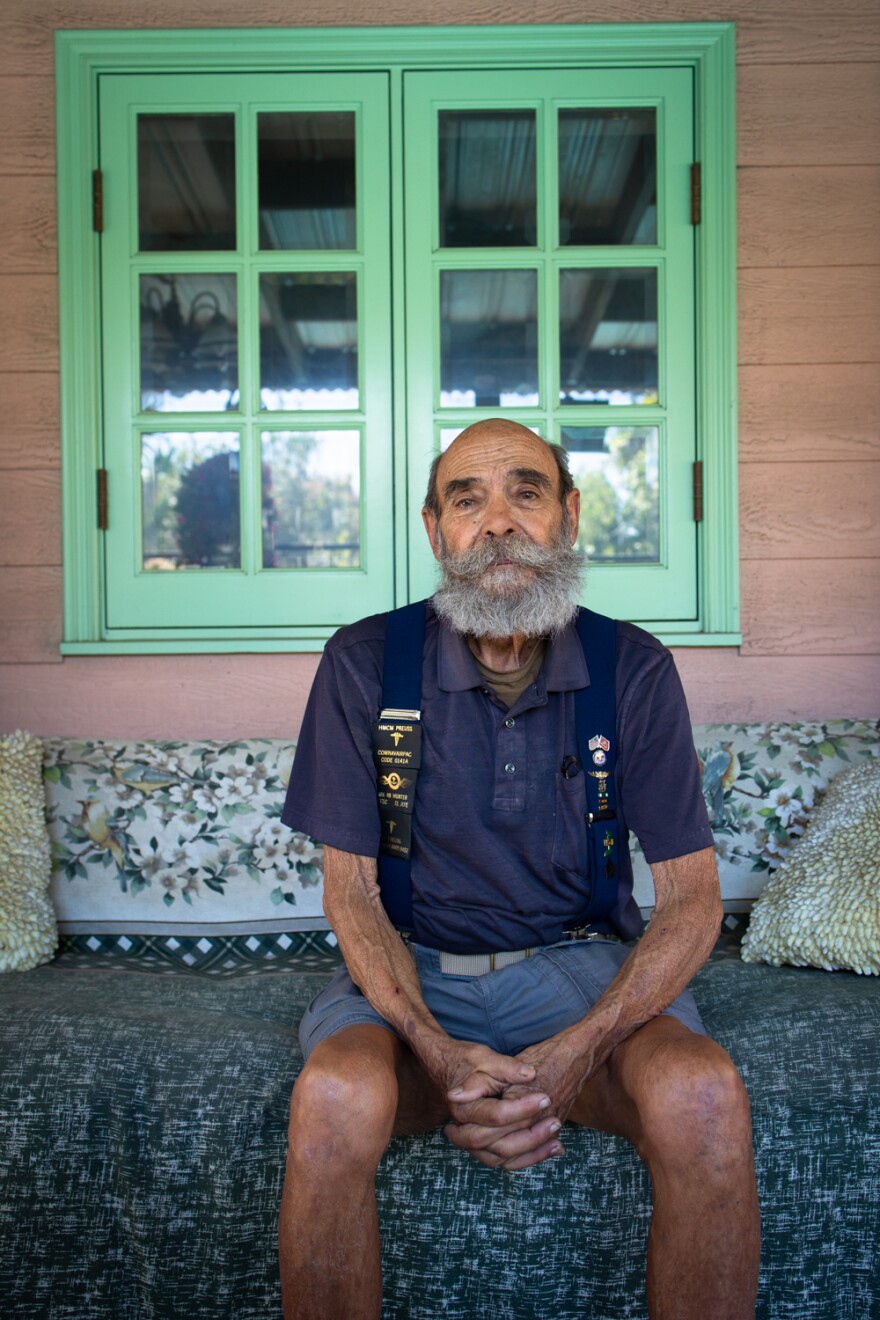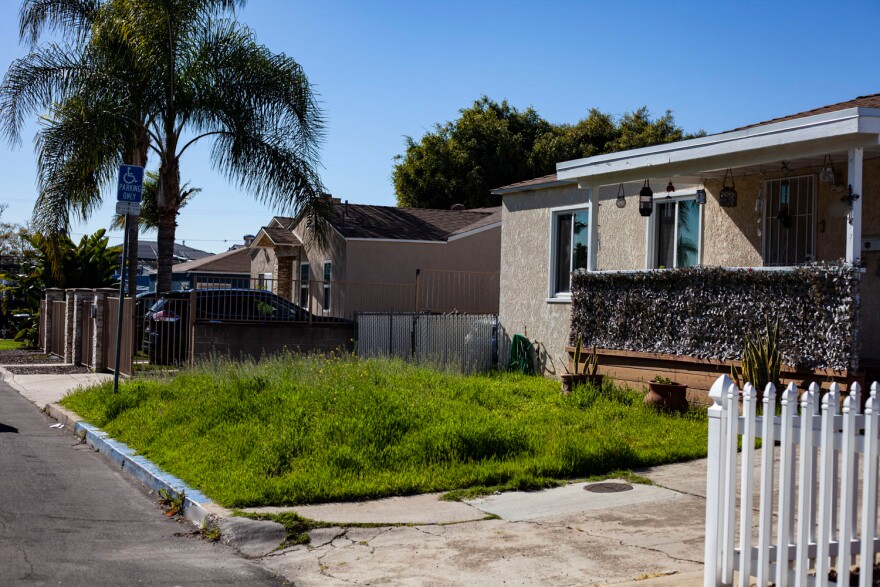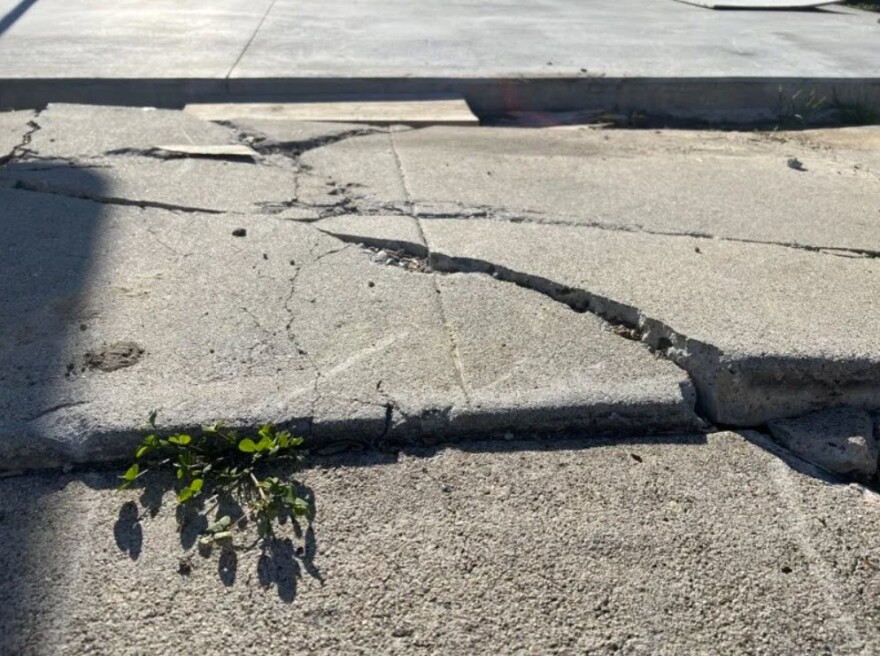Guy Preuss is obsessed with improving sidewalks in Paradise Hills. He once crossed the country to ask his Congress member for money to help widen sidewalks and improve parking. He also repainted the sidewalk along a decommissioned bus stop from red to gray so people could park there and because he said the city was taking too long to do it.
He started his advocacy three decades ago, after noticing a string of pedestrians killed in car accidents. He recalls asking himself: “Why don’t we have sidewalks?”
Now 81, Preuss still asks that question about the community he's lived in for most of his life. He serves on multiple community groups, including the Paradise Hills Village Council, which gives feedback to the city on much-needed infrastructure projects — or the lack of them – in his neighborhood.
Preuss and his fellow community council members are not the only ones complaining.

Second only to parking, sidewalk problems are driving complaints to the city from community members in the Skyline-Paradise Hills community planning area, which includes Paradise Hills and adjacent neighborhoods. That’s according to data from the city’s Get it Done app and online portal, which allow residents to report problems in their neighborhoods.
As of March 7, there were 272 sidewalk complaints currently unresolved in the area, making up 17% of total Get it Done reports. Of those, more than 150 are at least two years old, with one dating back to 2016 when the city launched the project.
Preuss says he’s waited years to see sidewalk issues addressed. For instance, he and his community council requested 48 sidewalk installations in 1995 and then again in 2011 “since no action by the city has taken place since then,” he wrote in a letter to the then-mayor.
Today, some of the areas Preuss flagged for needing sidewalks still just have segments or no sidewalk at all.
An inewsource analysis found that it takes the city on average 195 days to resolve a sidewalk issue in the Skyline-Paradise Hills, and 470 sidewalk complaints have been “closed” in the Skyline-Paradise Hills between 2016 and 2022.
But that doesn’t always mean they were repaired.
An audit last year of Get It Done data found that some reports have been inaccurately labeled closed when the complaint was just “referred” to the appropriate department for handling.
A closed sidewalk complaint could also mean the city decided it wasn’t responsible for repairing the sidewalk – a likely outcome in residential areas where the city makes private property owners largely responsible for sidewalk repairs. The cost to make those upgrades – averaging in the thousands of dollars, according to one city study – is cost-prohibitive for homeowners, critics of the policy have said.
Whatever the cause may be, Preuss and some of his neighbors have noticed one thing consistent: a lack of action.
“The current administration ignores us,” he said. “The only way you can make it better is for people to push.”
San Diego officials acknowledge that Paradise Hills, a San Diego neighborhood just east of Interstate 805 and north of State Route 54, has long been overlooked.
San Diego Mayor Todd Gloria “agrees that Paradise Hills has been underinvested for far too long, which is why this administration has moved quickly to reform infrastructure funding and planning policies as well as pass the largest infrastructure budget the City has ever had,” Gloria’s spokesperson, Rachel Laing, told inewsource in an email.
Laing said the city has recently taken steps to focus more resources in long-neglected communities. She pointed to policy changes that will allow money raised from development to be spent in communities outside where it’s raised, for example.
“Clearly we still have work to do, but this administration is righting the ship to deliver sidewalks and other critical community assets to historically underinvested communities,” Laing said.
Monica Montgomery Steppe, the city councilmember whose district includes the Paradise Hills and Skyline communities, said while in office, she’s pushed for money to install sidewalks in residential areas of Paradise Hills, including one completed last year on Sea Breeze Drive from Albemarle to Edgewater streets and another on Albemarle Street from Flintridge Street to Reo Drive. The Albemarle Street project likely will wrap up this year.
“These resources are reasonable and essential for our constituents' quality of life,” Montgomery Steppe said in an email. “Investment in this infrastructure is long overdue, and the City cannot continue to delay these projects in historically under-resourced communities like District 4.”
The city also has a little more than half a mile of road-paving projects planned for Paradise Hills, where more than 17,000 people live, as part of Mayor Todd Gloria's "Sexy Streets" initiative, which promises to fund infrastructure improvements in underserved neighborhoods.
The western portion of Paradise Hills, has been labeled by the city as a one of many “communities of concern,” which tend to have worse health outcomes and poorer quality of life than other communities due to a variety of reasons, including walkability. The city has identified the need for improvements in public transportation, open space, streets and parks in the community.
The neighborhood is mostly residential, almost completely populated by single-family homes with small pockets of high-density multifamily units and few commercial spaces. Many of the single-family homes have front yards that extend to the road with only a cement curb between.

Some residents say the most walkable sidewalks are in the only commercial corridor in Paradise Hills, which runs a block from Albemarle to Cumberland streets on Reo Drive. Mostly everywhere else in the neighborhood, sidewalks are narrow, damaged or missing.
Residents have reported injuries as a result.
In the city's Get It Done app, a resident at Calle Chanate reported tripping on “unpaved sidewalk” and twisting their ankle, an injury that required medical attention. A few miles south at Calle Gaviota and Roanoke Street, a parent reported that her daughter's scooter got stuck in a big gap in the sidewalk, causing her daughter to fall and “hurt herself.”
Citywide, settling claims for injuries caused by poor sidewalks cost the city on average about $1.5 million per year between fiscal years 2017 and 2021, amounting to the fifth-most costly type of liability claim the city settles, according to an annual risk management report. Last year the city paid an injury settlement of $150,000 to one plaintiff who tripped and fell while walking on a raised sidewalk in the North Clairemont community. The plaintiff lost her two front teeth, chipped a tooth, and dislocated an elbow, according to a staff report.
To avoid liability claims like these, the city should prioritize fixing the problems that lead to them, according to one city analysis. The burden that the city places on homeowners to improve sidewalks is one factor driving poor conditions.
Property owners are responsible for the cost of replacing or repairing sidewalks in San Diego, with some exceptions. Under a cost-sharing program, the city will pick up 50% of the cost if the sidewalks are “simply old and deteriorated” and the damage is not caused by the property itself or a third party. The city will cover the full cost under some circumstances, including when the damage is caused by city utility work, heat expansion or trees planted along a city street.
A recent city analysis found that few property owners take advantage of the cost-sharing program. From the 2015 to 2018 fiscal years, an average of 29 property owners participated each year, spending $4,500 on average.

In 2017, then-councilmember David Alvarez proposed eliminating the cost-sharing program, shifting the responsibility for sidewalk repairs mostly to the city and having the city replace unsafe sidewalks within 90 days. Alvarez, who represented communities in District 8 including Barrio Logan, San Ysidro and Tijuana River Valley, argued that placing the responsibility onto property owners to fix up the sidewalks — even if the city is covering half the costs — is unfair. He argued that because repairs were too costly, very few residents pay to fix city sidewalks, which leads to a backlog of repairs and especially affects low-income communities. Ultimately, his proposal failed.
Mayor Gloria’s office agrees that the cost-sharing program “was well intentioned but has been underutilized,” Laing said.
The administration is working on policy updates that include speeding up installations or repairs of city-maintained sidewalks and reducing permitting fees for private property owners to repair their sidewalks, she added.
In this year’s budget, the city plans to spend $7.8 million for new public walksways and sidewalk improvements citywide.
Meanwhile, Codis Harvey, who also grew up in Paradise Hills, says the city hasn’t done anything about a sidewalk safety issue he reported back in July 2021. Roots of a large tree mangled 50 feet of sidewalk and driveway outside of his home. He said he paid a contractor $800 to cut down the tree, but the sidewalk is still awaiting repairs.
“It seemed like they (the city) just blew it off really, really quick,” Harvey said.
His most recent report was closed after he received a notification from the Get It Done app that the city “determined that no action is warranted.” However, an earlier complaint remains open pending a “permanent repair” after the city put asphalt on just one part of the lifted sidewalk segment, he said.
“If they drove by, if they came here and looked at it, they would see there was some action that needed to be required.”
Harvey said he’s tripped on the lifted and separated sidewalk multiple times, luckily avoiding injury. But he’s scared that his mother, 64, or his finance’s grandmother, 81, who both visit his home, might hurt themselves one day.
“Even people that are walking their dogs by, it's a huge trip hazard,” he said.
As Paradise Hills’ sidewalk advocate, Preuss said it was once much easier for him to visit his local officials and ask for sidewalks in-person at City Hall. Nowadays, his other form of communication is his landline, so video calls and submitting Get It Done requests through an app are out of the question. A digital divide has made it nearly impossible for him to advocate for sidewalks, he says, but despite his frustration with the city, he’ll keep nudging his elected officials.
“You need to continue repeatedly.”









